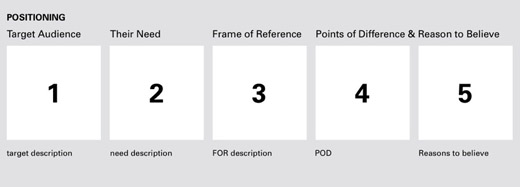
In our last post on brand positioning fundamentals, I reviewed the target audience need. The Motorola Droid was used as our example to illustrate the key elements in a classic positioning statement which are:
1. Your target customer
2. Their need
3. Their frame of reference
4. Your dramatic difference(s)
5. Your reason(s) to believe
Together they give us a positioning statement such as the one we’ve intuited for the Motorola Droid. For the technology leader who needs the latest and greatest device, the Motorola Droid is the iPhone killer, with a giant screen and the ability to run multiple applications with ease. You’ll note that we’ve set the Droid’s frame of reference as “iPhone.” Before we explain why, we need to cover the fundamentals.
Frame of reference can be dead simple or hard. It depends on the nature of your brand. As the name suggests, it is the target audience’s built-in mental frame of reference for your brand. Your frame of reference for Coca-Cola is likely “soft-drink.” Your frame of reference for Nintendo Wii is likely “gaming system.”
Bad Frame, Bad Brand
The wrong frame of reference reduces brand awareness because your target audience doesn’t immediately get it. Perhaps the most famous example of this situation is TiVo. Today the idea of a PVR (Personal Video Recorder) is a commonly understood frame of reference. But when TiVO launched, they ignored the importance of frame of reference. They should have used “VCR” as the customer’s frame of reference saying, “TiVO is like a VCR that can also…” Sure it may have hurt their pride to lump themselves into the category of the technology they were disrupting, but it would have increased awareness and consideration of their brand. Instead, it took a long time – too long – for their brand to catch on.
Frame of Reference Frames the Competition Too
One very helpful quality assurance test of your frame of reference is the competitors it creates. This is because the frame of reference determines the competition. So if TiVO had used VCR as its frame of reference, buyers would have seen other VCR brands as the competition and TiVO could have given their marketing some bite. But without a quality frame of reference, buyers weren’t sure with what to compare TiVo. This is also a great reminder of the essence of positioning: to position your brand against others.
Closer to home, a marketing agency client of ours was of two minds. Some felt that they were a “branding agency,” others a “digital agency.” So we had to have a conversation about their frame of reference. It was the discussion about competitors that resolved the split. We said “If you are a branding agency, then you are going to compete against Interbrand, BBDO and JWT. And you are going to compete for television spots, direct mail and lots more. Is that the kind of business you want to pitch?” The answer was a clear no. Their portfolio was perfect for winning against digital agencies like Organic. Thus “digital agency” became the frame of reference they use for their positioning statement.
When Considering Your Frame of Reference, Ask Yourself:
1. Is it one your target audience can instantly grasp without explanation?
2. Is it the right frame of reference?
3. Does it define competitors for your brand?
In our next post, we’ll tackle the frame of reference used for the Apple iPhone and the Motorola Droid. Both are great examples of strategic positioning wherein frame of reference plays a critical role.

